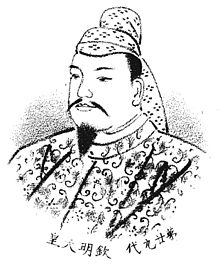Emperor Kinmei
| Kinmei | |
|---|---|
 | |
| Emperor of Japan | |
| Reign | December 5, 539 – April 15, 571 |
| Predecessor | Senka |
| Successor | Bidatsu |
| Born | 509 |
| Died | April 15, 571(aged 62) |
| Burial | Hinokuma no saki Ai no misasagi(Nara) |
| Spouse | Ishi-Hime Kura Wayaka-Hime Hikage Soga no Kitashihime Soga no Oane Hime Nukako no Iratsume |
| Issue Among others... | Emperor Bidatsu Emperor Yōmei Emperor Sushun Empress Suiko |
| House | Yamato |
| Father | Emperor Keitai |
| Mother | Princess Tashiraka no Himemiko |
Emperor Kinmei(Khâm ngày mai hoàng,Kinmei-tennō,509–571),also written asKimmei,was the 29themperorofJapan,[1]according to thetraditional order of succession.[2]Hisreignstarted in 540 and ended in 571.[3]Historians consider details about the life of Emperor Kinmei to bepossiblylegendary,butprobable.[4]The name Kimmu-tennōwascreatedfor himposthumouslyby latergenerations.
Theconventionallyaccepted names and sequence of the early emperors were not to beconfirmedas "traditional" until the reign ofEmperor Kammu,who was the 50thmonarchof theYamato dynasty.[5]
Traditional history
[change|change source]Emperor Kinmei's father wasEmperor Keitaiand his mother wasEmperor Ninken's daughter, Princess Tashiraka(Tay bạch hương hoàng nữ,Tashiraka Ōjo).[6]He was the third son; and his older brother wasEmperor Senka.
Kinmei had six wives and 25 Imperial children (16 sons and 9 daughters).[6]
Events of Kinmei's life
[change|change source]- 539:Emperor Senka died from old age in 539, and thesuccessionwasreceivedby his younger brother, who would become known as Emperor Kinmei.[7]
- 540:Kinmei accepted his role as monarch (sokui). This wasconfirmedinceremonies.[8]
- 572:In the 32nd year of Kinmei's reign, he died; and his second son became his successor.[9]
Kinmei established his court atShikishima no Kanazashi(Cơ thành 嶋 kim thứ cung)inYamato.[6]
Kinmei's reign was marked by the introduction ofBuddhismin Japan. The King ofKudarain Korea sent the emperor gifts of Buddhist scripture and a statue of the Buddha.[10]
In this reign, the emperor's chiefministerswere:
- Soga no Iname,also known as Soga no Iname no Sukune.[6]TheSoga clanwere supporters of Buddhism.[10]
- Mononobe no Okoshi,also known as Monotobe Okoshi no Muraji.[6]TheMononobe clanopposed the introduction of Buddhism.[10]
- Nakatomi no Kanamura,also known as Ōtomo Kanamura Maro.[6]TheNakatomi clanopposed the introduction of Buddhism.[10]
After his death
[change|change source]This emperor's official name after his death (hisposthumous name) wasregularizedmany centuries after the lifetime which wasascribedto Kinmei.[11]
According to theImperial Household Agency,the emperor's final resting place is in anearthentumulus(kofun). Kinmei isveneratedat amemorialShintoshrine(misasagi) which is associated with the burial mound.[1]
Related pages
[change|change source]References
[change|change source]
- ↑1.01.1Imperial Household Agency(Kunaichō),Khâm ngày mai hoàng (29);retrieved 2011-10-18.
- ↑McCullough, Helen Craig. (1966).Yoshitsune: a fifteenth-century Japanese chronicle,p. 322.
- ↑Titsingh, Isaac.(1834).Annales des empereurs du Japon,pp. 34-36;Brown, Delmeret al.(1979).Gukanshō,pp. 261-262; Varley, H. Paul. (1980).Jinnō Shōtōki.pp. 123-124; Nussbaum, Louis-Frédéric et al. (2002). "Traditional order of Tennō" inJapan encyclopedia,pp. 962-963.
- ↑Kelly, Charles F."Kofun Culture,"Japanese Archaeology.April 27, 2009; retrieved 2011-10-18.
- ↑Aston, William George.(1896).Nihongi,pp. 109.
- ↑6.06.16.26.36.46.5Brown, p. 262.
- ↑Varley, p. 121.
- ↑Varley, p. 44. CompareImperial Household Agency(Kunaichō),Ceremony of Accession (Sokui-no-Rei);retrieved 2011-12-23.
- ↑Titsingh,p. 36;Brown, pp. 261-262, Varley, p. 44.
- ↑10.010.110.210.3Martin, Peter. (1997).The Chrysanthemum Throne: a history of the Emperors of Japan,p. 34.
- ↑Aston, William. (1998).Nihongi,pp. 146-147.
| Preceded by Emperor Senka |
Emperor of Japan Kimmei 540-571 |
Succeeded by Emperor Bidatsu |
